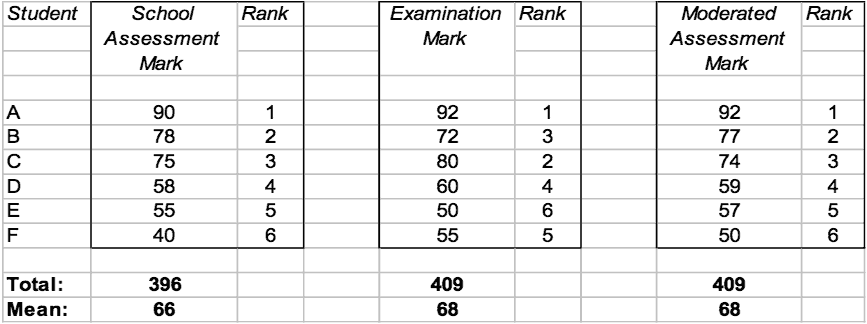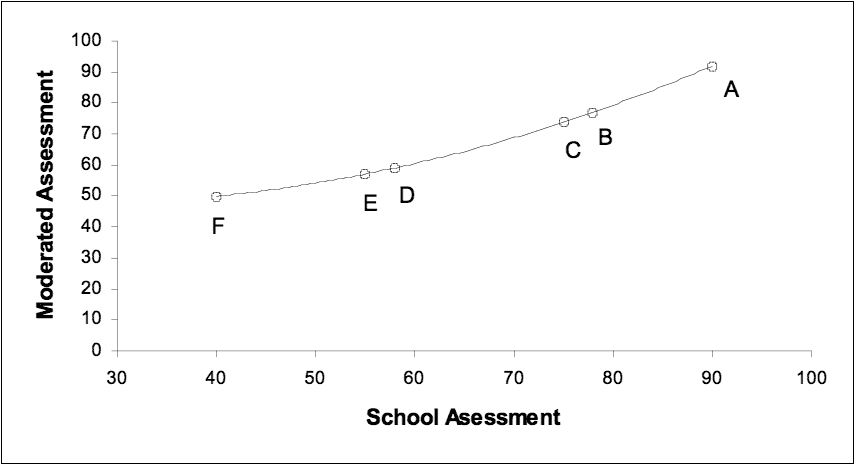Explanation of aligning and moderating procedures for the Higher School Certificate
For most HSC courses a student’s final result is determined by combining an examination mark with a school assessment mark.
Examination marks
For each question or task (item) in the examination, markers award a raw mark to every student response. In the case of optional items, students’ initial raw marks are sometimes adjusted to compensate for their difficulty relative to the compulsory section of the examination. This process is known as optional question scaling. All of the marks for a particular student are then added together to form a total raw mark for the examination.
Given that student achievement is reported in terms of performance standards, one further adjustment to the total raw marks is made. This adjustment aligns the raw total marks to performance band descriptions.
To achieve this alignment, a group of highly experienced markers, known as judges, decides how a student at the lower borderline of each performance band would respond to each examination item and then determines what raw marks such responses would achieve. These raw marks are then added together for each borderline, producing a recommended set of total cut-off marks.
This process of alignment is multi-staged, involving the review of a collection of materials: performance band descriptions, responses in the Standards Package, statistical feedback, and responses of current-year students consistent with the cut-off marks. Once this process is complete the judges will have determined which total raw marks correspond to the borderlines between each of the performance bands. For example, it may be recommended that a mark of, say, 82 is the minimum required for Band 6, 74 for Band 5, and so on.
Finally, for each band the total raw cut-off mark is mapped to the reported cut-off mark:
- For non-Extension courses the bands: 6, 5, 4, 3, and 2 have reported cut-off marks of 90, 80, 70, 60 and 50, respectively
- For Extension courses the bands: E4, E3, and E2 have reported cut-off marks of 45, 35, and 25, respectively.
Using the example given above, a student who achieved an examination mark of 82, and who was therefore deemed to have just met the standard for Band 6, would have a reported examination mark of 90. The student with an examination mark of 74, just meeting the standard for Band 5, would receive a reported examination mark of 80. Examination marks that that do not fall on the cut off marks are adjusted in a linear fashion. This means that, for example, a student with an examination mark of 78, which is half way between the Band 5 and Band 6 borderlines, would be reported as 85.
A committee of experts reviews the entire process of marking and aligning marks to the performance bands to ensure that the Board’s procedures have been followed and that the judges have maintained the standards for the course.
Assessment Marks
For most courses, students complete a program of assessment tasks that are set and marked at their school. Once the assessment program for a course is complete, the school submits total assessment marks for their students. Assessment marks for a course submitted from a particular school are produced under the same conditions so they can be compared. In this way, the submitted marks show both the rank order of students within a particular school/course group and the relative gaps between them.
It is important to note that all schools use different programs of assessment tasks and they all mark slightly differently. This means that students from different schools experienced different assessment conditions. For this reason, all HSC assessment marks that schools submit are adjusted by the Board using a process called moderation. This moderation process adjusts all of the school assessment marks in each course to a common scale: the examination. Once this is done, direct comparisons can be made between assessment marks awarded by different schools.
The assessment marks for each school/course group are moderated according to the same group’s examination performance. This process maintains both the rank order of students within the school group and the relative gaps between them.
The moderation process adjusts submitted assessment marks using three points:
- The mean of the school group’s assessments is adjusted to equal to the mean of the examination marks obtained by the students in that group.
- The top assessment mark is adjusted to equal to the highest examination mark obtained by any student in the group.
- Where possible, the bottom moderated assessment is equal to the lowest examination mark obtained by any student in the group. Note, however, that this is not possible when the distributions of the school assessments and the examination marks have very different shapes. In such cases the bottom moderated assessment mark may need to be moved up or down.
Note that if a school submits assessment marks with two (or more) students tied on the top assessment mark, then the top moderated assessment mark is equal to the mean of the top two (or more) examination marks. This is also the case if students are tied on the bottom assessment mark. Please also note that the standard deviation is never used to moderate school assessment marks.
A useful way of thinking about the moderation process is to view each school/course group as earning a total number of marks in the examination. The moderation procedures then distribute this total of marks in such a way that the rank order of the students as submitted by the school is not changed. As such, the total of the moderated assessment marks obtained by a school group in a particular course will be the same as the total of the examination marks obtained by that school group.
There are a number of safeguards in place to ensure that all students are treated fairly by the moderation process. In particular, some students are initially excluded from the moderation of the assessments of their group. These include:
- students who had an upheld illness/misadventure appeal and a relatively poorer examination result than assessment result;
- students whose performance in the examination is markedly below what was expected on the basis of their performance relative to the group in the assessment;
- other special cases as determined by the Board.
Excluding these students means that their examination marks are not included when the school group mean, maximum and minimum are calculated. As a result, their aberrant examination performance does not affect the moderation of assessment marks for their school group. The moderated assessment for these students is determined after completing the moderation for the rest of the group. Such students are given a moderated assessment mark that befits their assessment position in the school group. Students with an upheld illness/misadventure appeal are then awarded their moderated assessment mark also as their examination mark if the latter mark is lower. All other students retain their own examination mark.
Example
The following table (with figures rounded for simplicity) shows the school assessment marks, the examination marks and the moderated assessment marks obtained by a hypothetical group of six students who studied Modern History at Example High School. The rank order of the students on each set of marks is also given:

Points to note
Mean
During the process of moderation, the mean of the assessment marks submitted by the school (66) has been changed to make it the same as the mean obtained by that group in the examination (68). This means that, from a statistical point of view, it does not matter if the school assessment marks are ‘too high’ or ‘too low’, or ‘too wide’ or ‘too narrow’. The moderation process makes the required adjustment.
Moderated assessments and examination marks
The total of the moderated assessment marks obtained by this group (409) is the same as the total of the examination marks earned by the group.
The top moderated assessment mark is set equal to the top examination mark (92). Where possible, the bottom marks are also often equal, as they are in this case (50). There are occasions when, for technical reasons, it is necessary to move the bottom moderated assessment mark to higher or lower than the bottom examination mark. This can occur when the shape of the distribution of the school assessment marks is very different from that of the examination marks.
Rank order
The rank order of the students based on the moderated assessments is the same as the rank order of the students based on the school assessment marks. Note that the assessment rank order can be different to the examination mark rank orders, as is the case in this example for students B and C.
Relative differences (gaps)
The relative gaps between the students’ moderated assessments are similar to the relative gaps between students as shown in the school assessment marks. In this example, students B and C remain close together as do students D and E, while all other gaps remain further apart.
Conversion graph
The conversion relating the moderated assessments to the school assessments is given by a curve (a quadratic function) rather than a straight line. The conversion graph for this example is shown below.

Calculating the HSC mark and performance band for a course
After moderation, the assessment marks for all schools are on the same scale as the examination marks. Due to the common scale, the moderated assessment marks can be mapped to performance bands in the same manner that examination marks are mapped, using the cut-offs marks determined for the examination. The final HSC mark is the average of the reported examination mark and moderated Assessment Mark. This HSC mark determinesthe band into which a student’s performance falls. For example, if a student receives an examination mark of 92 and a moderated assessment mark of 89, then the average of these two marks is 90.5. As the HSC Course Report only displays integers, the HSC Mark is shown as 91, which is a Band 6 result.
For more information: http://www.boardofstudies.nsw.edu.au/hsc-results/moderation.html